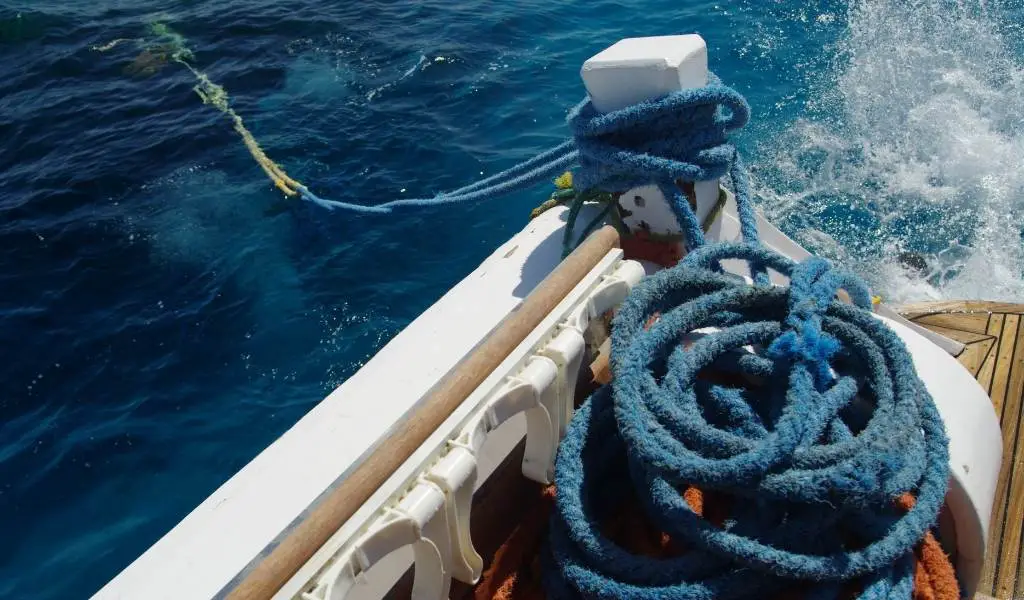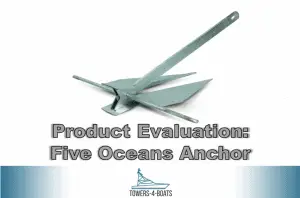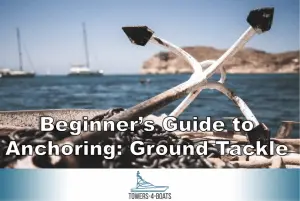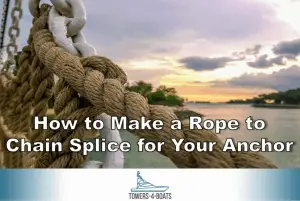The line that you attach to your anchor, whether all nylon, all chain, or a combination of the two, is referred to as your anchor rode.
Small boats usually carry their primary anchor on a combination nylon line and galvanized chain. Setting up the system requires answering some basic questions about the type of boat you’re running, the places you might anchor, and how long you plan to stay on the hook.
As a boat owner looking to do everything correctly, you’ve probably asked how long should your anchor line be?
You should have 8 feet of anchor line for every 1 foot of anchoring depth. To work out anchor line length, multiply the expected depth you will be anchoring in by 8. Most boats have about 150 to 200 feet of anchor line to give you enough for any situation.
If using rope, it’s also important to calculate the right anchor line diameter size:
To calculate the correct diameter of anchor line, you should multiply every 9 feet of boat length by 1/8”. So, if you have a 23-foot boat, you’ll need 3/8″ line.
Chain and Rope
Most small boats use a combination nylon rope and galvanized chain for their anchor rode. Read my article on How to Make a Rope Chain Splice for Your Anchor.
Even though most of your line is made of nylon rope, you’ll want the last few feet closest to the anchor to be chain. This provides more weight near the anchor, which helps it hold better. The weight of the chain will ensure that your nylon rope does not pull up on the anchor, making it want to pop out of the bottom, and instead pulls horizontally on it.
The chain also prevents chafe. Near the anchor, the line will be scooting back and forth along the bottom as the boat moves around. If there are sharp rocks nearby, you’ll appreciate having some heavy chain there to keep the nylon safe.
The proper way to connect the rope and the chain is a chain splice. The splice constricts itself as line tension is increased. It also preserves the strength of the line, whereas any other type of knot or attachment will be a weak point. You can purchase pre-sliced combination rodes that are ready to go.
If you only use your anchor for the occasional lunch-hook, very small boats can get away without using chain on their rodes. But if you anchor a larger vessel, anchor, in any sort of weather or for extended periods of time, you’ll need at least some chain in your system. If you plan on extended cruising, you should upgrade to an all-chain rode.
Rode Length
How much line you need to have onboard is a separate question. It is primarily based on how deep the water is where you think you’ll be anchoring. But even if you only anchor in shallow water, you’ll want enough on board so that you can use the anchor in case of emergency.
Anchors will only produce holding power if they are hooked into the bottom and the load is applied at a shallow angle. The scope of your anchor line is the angle it forms to the bottom of the sea bed. If you drop the anchor in ten feet of water, and then only let out ten feet of anchor line, the line will be vertical. While the anchor is sitting on the bottom, any movement of the boat will just drag it along. Likewise, if you put out twenty feet of line, it is still nearly vertical. By the time you get to 30 or 40 feet of line, it will likely hold, but it won’t be very secure. The more line you play out, the less strain there is on the anchor and the better it holds.
The optimum scope for a nylon rode is 8:1, meaning that for every one foot of depth you have eight feet of rode put out. If you are expecting storms or bad weather, 10:1 is in order. Remember, for this purpose “depth” is measured from the bow roller, so you will need to add a few feet to the water depth depending on how tall your bow is. Additionally, all your calculations should be made from the high tide depths.
Most boats carry between 150 and 200 feet of anchor rode. This enables regular anchoring in depths of around 20 to 30 feet and a bit less in serious winds. If you anchor somewhere with very deep anchorages, consider 250 or 300 feet of rode.
Other Considerations:
- Tie the Bitter End
Always remember to tie off the bitter end securely. Even if you don’t plan on using all of the line, you never know when it might slip out of your hand or an unknowing helper lets it all fly overboard.
- Use Load Tested Shackles
You’ll attach your anchor rode to your anchor with a shackle. Shackles should be one size larger than the chain you are using. Any shackles in your system should be considered the weakest link in the system, so make sure they are the strongest ones you can find. Quality shackles are load-tested, and yes, they cost a little more.
- Secure the Shackle Pin
You should also be very careful with the shackle pins. Shackle pins should be secured with seizing wire to ensure they don’t work themselves loose, either in the anchor locker or on the sea bottom.
- Inspect Your System Regularly
To this end, you’ll also want to inspect your anchor rode occasionally. If you anchor often, then doing so every time you launch and retrieve your anchor is a good policy. If you only use it sometimes, try to take a look at before every big trip.
Anchor Windlasses
If your boat has a windlass, you don’t have as many options when picking your anchoring gear. The gypsy on your windlass, which is the piece that holds your rope and chain in places, is only rated for a certain size rope and chain.
You can purchase a new gypsy, and most windlass manufacturers make several sizes appropriate for their models. This is an extra expense to consider, and you’ll have to make sure it matches exactly. If you gypsy feeds chain, you must match not only the diameter of the chain but the type of chain as well.
Some windlass gypsies will feed combination rope and chain rodes. Most, however, are designed for chain only. Be sure your windlass is compatible with what you want to feed through it.
If you’re looking for a new windlass, this Minn Kota DeckHand is suitable for anchors up to 40lbs and has 100ft of nylon rope pre-spooled and ready to go.
Rope Materials
Most rope anchor lines use a three-strand nylon line. Nylon makes the perfect anchor line because it is very strong and it stretches, which provides some shock absorption. Another option for anchor line is an eight-plait nylon line, which has a nicer feel than three-strand and lays flat without twisting. This rope is commonly used when the line runs through an electric windlass.
Modern lines, like Dyneema or Spectra, are ill-suited for use as an anchor rode. While they are lighter and stronger than nylon, they do no stretch. This can produce a hard ride on you at anchor as well as transferring dangerously high loads to your anchor gear and deck hardware.
Instead, I recommend this nylon 3 strand rigging line which is made with 100% nylon. It has a specific gravity of 1.14 meaning it will sink easily.
The diameter of the rope depends on how strong the system needs to be, which is a function of how large a boat it is expected to hold and in what conditions. The bigger the boat or the stronger the winds, then the bigger the rope, chain, and anchor need to be.
A common rule of thumb for calculating what size anchor line to use is to multiply every nine feet of boat length by 1/8”. So, an 18-foot skiff would need 1/4” line, while a 36-footer would need 1/2” line. Be sure to round up, so if your boat falls between values go to one size of line higher. So a 38-foot vessel would use 5/8” line.
To fine-tune this rule of thumb, if your boat is very heavy or has a lot of windage, you can use 1/8” of line per eight feet. If your boat is smaller, lighter, or sleeker, then 1/8” of line per ten feet will suffice.
Chain Materials
Picking the right chain is much the same process as picking the right nylon rode. First, pick the right material and then choose the right diameter.
According to West Marine, there are three main types of chain appropriate for anchoring. The best and most common choice is G4 high-test (HT) chain. This is a high-carbon galvanized steel chain. Most anchor windlasses are compatible with it. G4 has mostly replaced BBB chain as the anchoring chain of choice, but BBB is still available and is compatible with many windlass gypsies. There is also G7 transport chain, which offers great abrasion resistance and high strength. Unfortunately, this chain isn’t usually compatible with many anchor windlasses.
Stainless steel chain is also available on the anchoring aisle of your local marine store. While the stainless is shiny and pretty, most boaters can take a pass on the extra expense. Stainless steel’s only advantage is its resistance to rust. It’s mostly for looking flashy on the deck of a yacht.
Pick a chain that is half the size of your anchor line. So boats using 1/2” nylon line would use 1/4” BBB chain. If using G4 high-test chain, you can reduce this by 1/16”, so a boat with 1/2” line could use 3/16” G4 chain.
Conclusion
Your rode keeps you attached to your anchor, so making sure it’s the right kind to support your boat and the strong enough to handle any weather you come across is important. Once you’ve set up your anchor rode correctly, it should provide years of reliable service.






